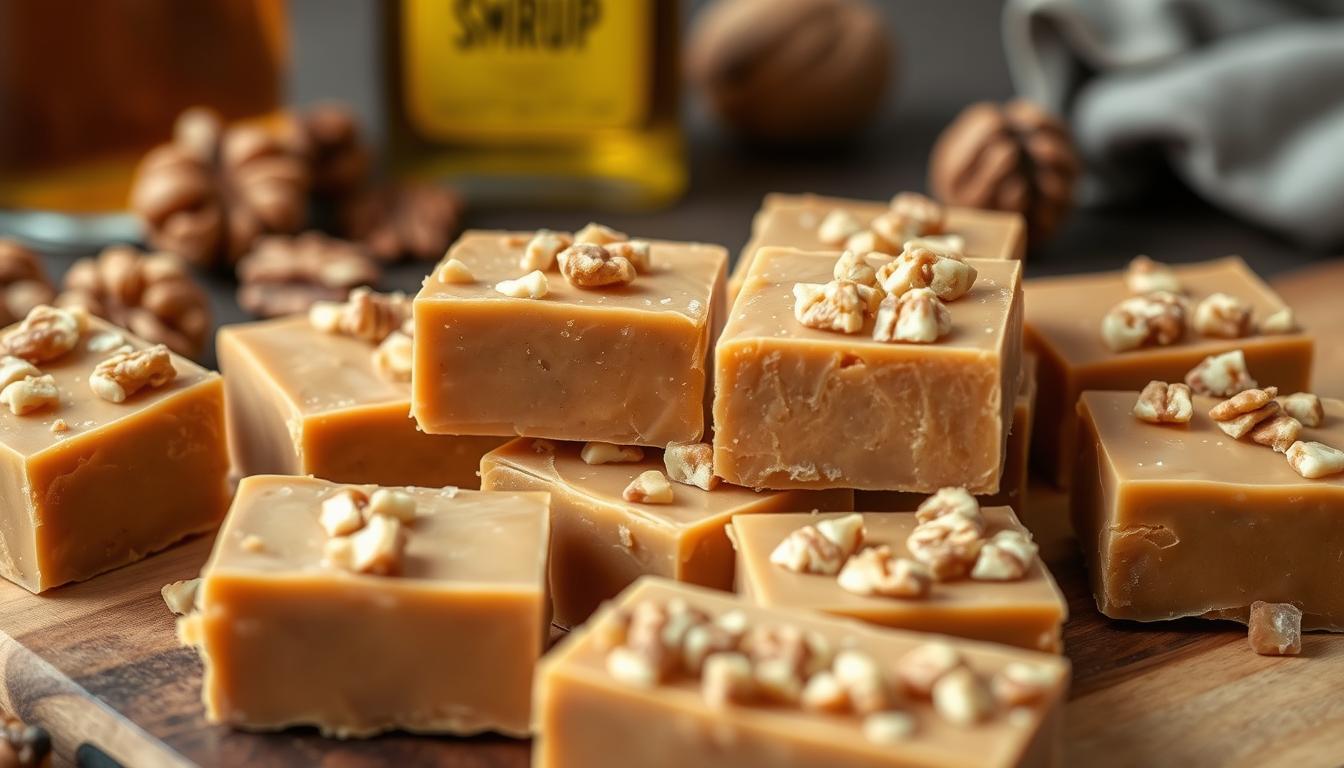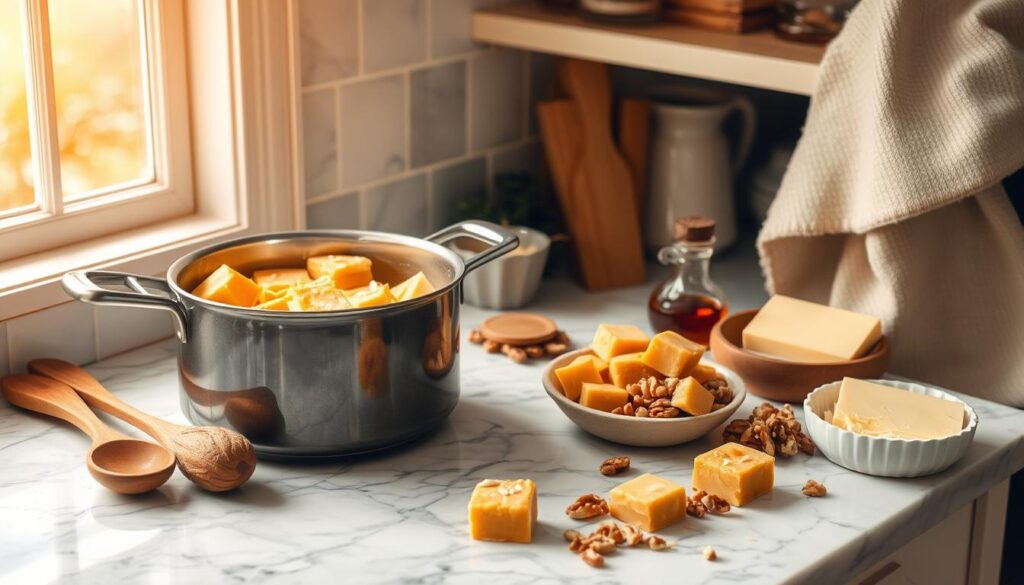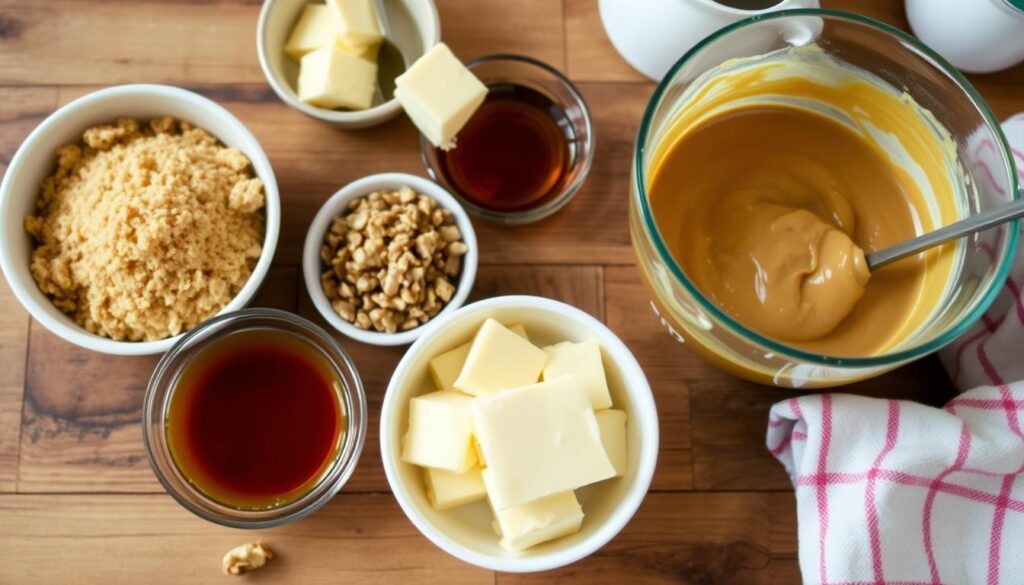The smell of creamy Butterscotch Maple Walnut Fudge fills the air. It mixes with the scent of toasted walnuts and maple syrup. Looking at the shiny fudge, you feel a rush of nostalgia. It takes you back to cozy winter afternoons in the kitchen, making these treats.
We’re going to explore making the best homemade butterscotch maple walnut fudge. We’ll learn about the key ingredients and techniques. Plus, we’ll discover how to get that silky texture. This will make you a pro at making candies in your kitchen.
Key Takeaways
- Discover the key ingredients and equipment needed to craft homemade butterscotch maple walnut fudge
- Learn the science behind creating the perfect smooth and creamy fudge texture
- Explore step-by-step instructions and techniques for making this indulgent treat
- Understand how to balance the flavors of maple and walnuts to create a harmonious blend
- Troubleshoot common fudge-making challenges and learn storage tips for maximum freshness
Introduction to Artisanal Butterscotch Fudge Making
Making homemade candies, like our tasty butterscotch fudge, is an art. Learning to make rich, creamy caramel treats is rewarding for anyone who loves cooking or making artisanal delicacies. We’ll cover the basics of fudge-making, including the tools and terms you need to make perfect butterscotch fudge at home.
Understanding the Art of Homemade Fudge
Fudge-making is a mix of science and creativity. It involves controlling temperatures and understanding how crystals form. With patience and attention to detail, you can make your own smooth and creamy candies at home.
Essential Equipment and Tools
To make great fudge, you need the right tools and equipment. You might already have most of what you need in your kitchen. Here are some key tools:
- Heavy-bottomed saucepan
- Candy thermometer
- Wooden spoon or silicone spatula
- Baking pan or mold
- Parchment paper or silicone baking mat
Basic Fudge-Making Terminology
Before you start making fudge, learn some key terms and techniques. Knowing about “soft ball stage,” “crystallization,” and “tempering” helps you understand the science behind making great butterscotch fudge. With this knowledge, you’ll make delicious fudge every time.
Essential Ingredients for Perfect Butterscotch Maple Walnut Fudge
Creating the perfect homemade indulgences like butterscotch maple walnut fudge starts with top-notch ingredients. This gourmet confections needs a mix of key parts for the right taste and smooth texture. Let’s look at the must-have ingredients for this rich treat.
High-quality unsalted butter is at the core of this recipe, giving it a creamy base. Brown sugar, with its caramel taste, is key for the butterscotch flavor. Sweetened condensed milk makes the fudge silky and smooth.
Pure maple syrup and plenty of chopped walnuts are crucial for boosting the flavors. The maple syrup adds a warm, earthy sweetness. The walnuts bring a nice crunch and nutty flavor.
Finally, vanilla extract adds a classic taste, and a pinch of salt balances the sweetness. This enhances the overall flavor.
By choosing and mixing these quality ingredients, you’re on your way to making the best homemade indulgences and gourmet confections. You’ll get a decadent butterscotch maple walnut fudge that will impress anyone and satisfy your sweet cravings.
The Science Behind Creating Smooth and Creamy Fudge
Making the perfect fudge is all about understanding the science. It’s about controlling temperature, managing crystallization, and getting the right texture. These steps are key to creating a delicious treat.
Temperature Control Techniques
Getting the right temperature is crucial for smooth fudge. By monitoring and adjusting the heat, you can mix ingredients perfectly. This ensures a silky texture without graininess.
Crystallization Process
The way sugar crystals form affects fudge texture. Cooling rate, stirring, and adding “seed” crystals are important. They help create a smooth, creamy fudge.
Achieving the Perfect Texture
It’s all about balancing temperature, crystallization, and ingredient ratios. By mastering these, you can make fudge that’s both creamy and indulgent. Your loved ones will love it.
| Temperature Range | Ideal Fudge Texture |
|---|---|
| 230°F to 240°F | Soft, creamy, and spreadable |
| 245°F to 250°F | Firm, yet still pliable |
| Above 250°F | Harder, more brittle texture |
Mastering temperature control, crystallization, and texture makes your fudge stand out. Become a fudge artisan and enjoy the fruits of your labor!
Post Image Butterscotch Maple Walnut Fudge
Look at this amazing homemade butterscotch maple walnut fudge! It’s a feast for your senses. It has a golden-brown color and a mix of sweet and nutty tastes.
This butterscotch maple walnut fudge is made with top-notch ingredients. It has a smooth texture and a taste that’s hard to resist. The top is sprinkled with walnuts for a nice crunch.
The candies are cut into neat squares, looking great on any dessert table or in a gift box. The smell of butterscotch fills the air, making you want to try it.
“This butterscotch maple walnut fudge is a true work of art. The flavors are impeccably balanced, and the texture is simply divine. It’s a confectionery masterpiece!”
Whether you love fudge or are new to candies, this post image butterscotch maple walnut fudge will impress you. It’s a mix of sweet and crunchy that you’ll love in every bite.
Step-by-Step Cooking Instructions and Techniques
Making homemade butterscotch maple walnut fudge is a fun process. It needs careful attention and some skill. Start by getting your workspace ready for a smooth fudge-making journey.
Preparing Your Workspace
First, collect all the tools and ingredients you need. Make sure your work area is clean and clutter-free. Use parchment paper or grease a baking pan to stop the fudge from sticking.
Have your mixing bowls, spatula, and other tools ready. This will help you stay organized and efficient.
Mixing and Heating Process
In a heavy-bottomed saucepan, mix sugar, butter, milk, and maple syrup. Heat it over medium heat, stirring constantly to avoid burning. When it hits 234°F to 240°F, take it off the heat.
Stir in vanilla extract and chopped walnuts. This adds flavor and texture to your fudge.
Cooling and Setting Methods
Pour the hot fudge into the prepared pan and spread it evenly. Let it cool at room temperature for 30 minutes. Then, move it to the fridge to cool and set completely, which takes 2 to 3 hours.
Once it’s firm, cut it into squares. Now, you can enjoy these caramel treats or homemade indulgences.
“The key to perfectly creamy and smooth fudge lies in the careful temperature control and cooling process.”
Adding the Perfect Maple and Walnut Flavor Balance
Making the best gourmet confections and artisanal delicacies is all about balance. Your homemade butterscotch maple walnut fudge needs the right mix of butterscotch’s caramel taste and maple and walnut’s nutty warmth. Let’s look at how to get that perfect flavor.
To get a balanced fudge, choose top-notch maple syrup and toasted walnuts. Mix the maple syrup into the butterscotch carefully, so the sweetness blends well. Then, add the chopped walnuts evenly to add a nice texture.
When adding maple and walnuts, timing is everything. Add the maple syrup when the fudge is almost ready, to keep its fresh taste. Also, mix in the walnuts after pouring the fudge into the pan, so they stay crunchy and flavorful.
By balancing butterscotch, maple, and walnut flavors, you’ll make a fudge that’s irresistible. You’ll end up with a rich, gourmet confection that shows off your fudge-making skills.
Troubleshooting Common Fudge-Making Challenges
Making the perfect confectionery is a delicate task. Even those who love desserts can face problems. But don’t worry, we have solutions for your sweets-making issues. Whether it’s a grainy texture or setting problems, these tips will fix your fudge fast.
Fixing Grainy Texture
A grainy texture often comes from overheating or not dissolving sugar right. Here’s how to fix it:
- Use the right sugar type and amount. White sugar is common, but brown sugar or blends can add flavor.
- Keep the temperature right during cooking. Too high and sugar crystals form too soon.
- Stir constantly to spread heat evenly and avoid hot spots.
Addressing Setting Issues
If your fudge won’t set or is too soft, it might be cooking or cooling issues. Try these fixes:
- Cook the mixture to 236-240°F for the perfect soft-ball stage.
- Let the fudge cool completely before shaping. Rushing can stop it from setting right.
- Adding corn syrup or cream of tartar can help it set firmer.
Moisture Control Tips
Moisture can ruin your fudge, making it sticky or soft. Here’s how to avoid it:
- Measure ingredients carefully to avoid extra moisture.
- Keep the cooking and cooling area dry to avoid adding moisture.
- Store fudge in an airtight container at room temperature, away from sunlight and heat.
By tackling these common confectionery problems, you’ll make perfect fudge. Happy baking!
Storage Tips and Shelf Life Guidelines
Keeping your homemade butterscotch maple walnut fudge fresh is important. This way, you can enjoy these tasty candies for a longer time. Here are some tips to help you store your candies perfectly:
- Store fudge in an airtight container at room temperature, away from direct sunlight or heat sources.
- For optimal freshness, consume your homemade indulgences within 7-10 days of making them.
- Refrigeration can extend the shelf life to 2-3 weeks, but be mindful of potential texture changes.
- Freeze fudge in an airtight container for up to 3 months, then thaw at room temperature before serving.
By storing your fudge right, it will stay rich in flavor and smooth in texture. Enjoy every bite of these homemade treats!
“The secret to keeping fudge fresh is all in the packaging and storage technique. Treat your homemade candies with care, and they’ll reward you with delightful flavor every time.”
Creative Variations and Flavor Combinations
Exploring the world of gourmet confections, the butterscotch maple walnut fudge offers endless possibilities. You can change it up for different seasons or dietary needs. This beloved treat can be made to please many tastes and diets.
Seasonal Adaptations
As the seasons shift, so can your fudge’s flavors. Add festive spices like cinnamon, nutmeg, or pumpkin pie spice for a cozy feel in fall and winter. Spring brings citrus, and summer invites mint or fruity touches.
Dietary Modifications
- Try using maple syrup, honey, or coconut sugar for a sweet yet healthy fudge option.
- Make it dairy-free by swapping butter with coconut oil or nut butter. This is great for those with lactose intolerance or vegan diets.
- Add chopped nuts, seeds, or dried fruits for a crunchy texture and extra nutrition.
Homemade fudge is all about being versatile. You can make it your own, fitting it to your taste and dietary needs. Dive into the world of flavors and create something truly special.
Creating amazing fudge is all about finding the right mix of sweet, creamy, and rich flavors. With a bit of creativity and attention to detail, you’ll make treats that everyone will love.
Conclusion
Making your own post image butterscotch maple walnut fudge is a fun and rewarding task. It lets you create delicious, creamy treats that everyone will love. The joy of making your own fudge is unmatched.
In this guide, you’ve learned how to make perfect post image butterscotch maple walnut fudge. You now know about temperature control, crystallization, and how to balance texture and flavor. You’re ready to become a pro at making fudge.
Whether you try new flavors or stick with the classic, your fudge will be a hit. Enjoy sharing these tasty treats with your loved ones. Experience the joy of homemade confectionery goodness.
FAQ
What are the key ingredients for making butterscotch maple walnut fudge?
To make butterscotch maple walnut fudge, you need top-quality butter, brown sugar, and heavy cream. Also, maple syrup and chopped walnuts are key. These ingredients mix to create a rich, creamy, and flavorful treat.
What equipment and tools are needed for fudge-making?
You’ll need a heavy-bottomed saucepan and a candy thermometer for making fudge. A sturdy wooden spoon, a baking pan, and a sharp knife for walnut chopping are also necessary.
How do I achieve the perfect smooth and creamy texture in my fudge?
For smooth fudge, control the temperature and mix carefully. Make sure the mixture hits the right temperature. Avoid over-stirring and let it set properly for a creamy texture.
How do I incorporate the maple and walnut flavors into the fudge?
Add maple syrup while cooking and fold in walnuts at the end. This balances the flavors. The maple syrup infuses the fudge, while walnuts add crunch and aroma.
What are some common fudge-making challenges and how can I troubleshoot them?
Grainy texture and setting issues are common. For a grainy texture, re-melt and add cream. For setting, adjust the temperature or add corn syrup. Control moisture to avoid problems.
How should I store my homemade butterscotch maple walnut fudge and how long will it last?
Store the fudge in an airtight container at room temperature. It lasts 1-2 weeks. Refrigeration can extend life but may make it firmer.
Can I create variations or customize the flavors of my butterscotch fudge?
Yes! Try different ingredients and flavors. Use seasonal items, other nuts, or dietary changes to suit your taste and needs.



